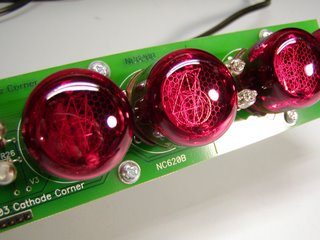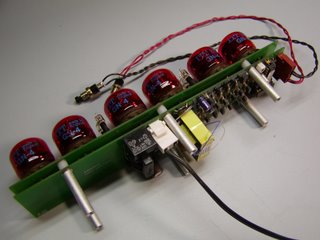Nixie Clock



Cathode Corner's NC620 kit arrived at my place a few days ago. It's been a long while since I've worked with thru-hole components and printed circuitboards which is what the kit comprises of. I miss that old era of electronics. Everything I deal with at my job these days is surface mount technology. It's a pain in the ass no matter how you work with it. Anyway after reading over the nixie clock kit's instructions I was impressed with Cathode Corner's design and excellent documentation. From start to finish the entire project only took me a total of five hours broken up over two nights. I was going easy on it too, drinking beers while I installed components and soldered them into place. I had a great time.
The clock functions perfectly. At night it's real cool because it floods my room with a warm orange glow like a fireplace.
Shopping around online for nixie clock kits I found about a half dozen designs that looked good. Cost was a factor though as some of them were in the $500-$800 range. That was far too much above what I was willing to spend. Also, one or two of those expensive kits didn't even include a set of tubes. You were supposed to go out on your own and find some. Shitty. I chose Cathode Corner's kit because it was affordably priced and it came with a full set of six vintage new old stock nixies. They looked pristine when I removed them from the box.
Nixie vacuum tubes first hit the electronics world in the 1950s. For about two decades most electronic devices that had a numeral display used nixies. Inside each nixie there's a set of thin metal filaments shaped 0 through 9. The numbers are lit up individually by running current through a specific set of pins at the vacuum tube's base. Pretty simple stuff. Previous to nixies, there were bulky vacuum tubes called Dekatrons that had a pie shaped metal element inside. They acted like primitive display devices by spinning a light around. The faster the light spun the faster a dekatron was counting. Dekatrons were replaced by nixies, nixies were rendered obsolete by seven segment LEDs. Nixies were expensive to manufacture and generally used above 150VDC to ignite. By the 1970s LEDs were cheap to produce and only required a small amount of power compared to vacuum tubes. They eventually replaced Nixie tubes in every application. These days nixies are more of a nostalgic item than anything else.




1 Comments:
i have a few links on the right there for nixie kits Wad. you may want to take a look at Sphere's clock kits as they're nice and straightforward. the cost isn't bad either.
one of my next projects is theramins. i fucking hate the damned things but i have a few friends that are into electronic music so i'm going to build a few of those kits and then give them away. i just want the kits to build for fun. as soon as they're done i want them the hell out of here! god damned crazy UFO music bullshit makers that they are...
Post a Comment
<< Home